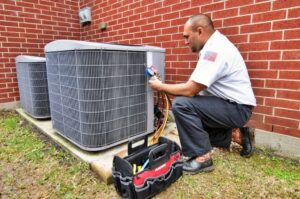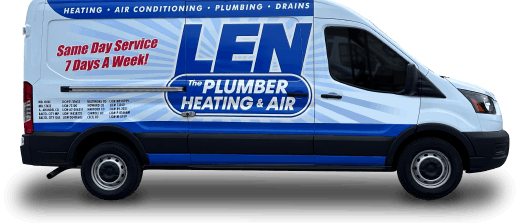What Are the Most Common Questions About Air Conditioning?
 Air conditioning is crucial for staying cool during the hottest months, and understanding how it works can help you protect it and keep things running smoothly. Whether you’re a new homeowner or simply looking to get more from your cooling system, knowing the basics can save you time, stress, and money.
Air conditioning is crucial for staying cool during the hottest months, and understanding how it works can help you protect it and keep things running smoothly. Whether you’re a new homeowner or simply looking to get more from your cooling system, knowing the basics can save you time, stress, and money.
From routine maintenance tips to energy-saving and troubleshooting, we’re answering some of the most common questions homeowners have about air conditioning. With our help, you’ll stay cool, informed, and in control year-round!
How Much Is a New Air Conditioning Unit?
You can expect to pay between $3,800 and $7,500 for a new residential air conditioning system. AC unit costs vary based on your home’s size, the complexity of installation, and the unit’s SEER (efficiency) rating. Ductwork updates or retrofits, thermostat replacements, and labor may also factor in additional costs.
It’s always best to seek a professional consultation to find the best air conditioner for your budget and home.
How Do I Maintain My Air Conditioning System?
Regular HVAC maintenance goes a long way toward protecting the efficiency and longevity of your AC.
Remember to change your unit’s air filters every 1-3 months to keep airflow clean and unobstructed. It’s also important to clean the condenser and evaporator coils once a year to prevent buildup that can strain the system. A professional AC tune-up once a year will clean your air conditioner’s internal components. For best results, schedule AC maintenance in early spring—right before you need it most.
Can My Air Conditioning Make Me Sick?
While air conditioning itself doesn’t make you sick, a poorly maintained system can contribute to ongoing health issues. Dirty air filters or ducts may circulate dust, mold, and allergens, aggravating asthma or allergy symptoms. Cold, dry air can also irritate the respiratory system, especially for those with underlying conditions. To reduce health risks, change your air filters regularly and keep indoor humidity levels balanced. With a few simple measures, you’ll maintain healthy indoor air quality.
How Long Do Air Conditioning Units Last?
Most air conditioning units last 12 to 15 years with proper maintenance. Preventative care—like changing filters, cleaning coils, and scheduling annual tune-ups—can help extend your system’s lifespan. If your AC is frequently breaking down, causing your energy bills to spike, or struggling to cool your home evenly, it may be time to consider a replacement. Stay on top of any changes to catch necessary repairs early.
Why Is My Air Conditioning Unit Leaking Water?
Water leaks from an AC unit are often caused by a clogged condensate drain line, frozen evaporator coils, or a dirty air filter restricting airflow. If not addressed promptly, leaks can lead to water damage, mold growth, or even system failure. At the first sign of a leak, check your air filter and ensure the drain line isn’t blocked. If the issue persists, it’s best to call an HVAC technician for a lasting solution.
How Do You Repair an Air Conditioning Unit?
There are a few steps you can take on your own, like checking the thermostat settings, replacing or cleaning air filters, and ensuring the unit has power. If you’re still noticing performance issues after DIY checks, it’s time to call an HVAC specialist. A licensed technician can diagnose and repair more complex problems, including refrigerant leaks, electrical faults, or faulty capacitors. Paying attention to urgent issues will prevent costlier repairs down the line.
What Is Ductless Air Conditioning?
Ductless air conditioning, also known as a mini-split system, delivers efficient cooling without traditional ductwork. It includes an outdoor unit connected to one or more indoor units, offering targeted temperature control in specific rooms or zones. Ductless systems are great for homes without existing ducts or spaces needing independent climate control.
Ductless mini-splits are energy-efficient, straightforward to install, and operate quietly, making them a modern cooling solution.
How Does Central Air Conditioning Work?
A central air system cools your entire home through a network of parts working together. Central air includes a condenser (typically located outside), an evaporator coil, an air handler, and a duct system that distributes cool air throughout your home. It cools your home by circulating refrigerant, which absorbs heat from indoor air and releases it outside.
Controlled by a thermostat, a central air system helps maintain consistent, whole-home comfort by automatically adjusting to your preferred temperature settings.
What Is a Mini-Split Air Conditioning Unit?
A mini-split air conditioner is a type of ductless system that provides targeted cooling without ductwork. It consists of an outdoor compressor and one or more indoor air-handling units connected by refrigerant lines. Mini-splits are ideal for room additions, garages, or spaces that need zoned temperature control. They’re also a popular choice for homes looking to expand cooling without major renovations.
Can a Nest Thermostat Replace Heating and Air Conditioning Controls?
Yes, a Nest thermostat can replace most traditional heating and cooling controls, since it’s broadly compatible with HVAC systems. Before connecting it to your central air, furnace, heat pump, or mini-split, check the wiring requirements. Nest thermostats offer smart features like automated scheduling, remote access, and energy-saving features. For dual-fuel systems or complex setups, we recommend a professional installation.
How Do I Charge My Home Air Conditioning System?
Charging your air conditioning system means adding refrigerant to keep it cooling efficiently. Replenishing refrigerant requires an EPA-certified technician since the process involves the safe and legal handling of chemicals. Your AC may need a recharge if it’s blowing warm air, making hissing sounds, or has iced-over coils. While it might be tempting to try charging it yourself, it’s always best to rely on a professional to avoid potential environmental or system damage.
Does Air Conditioning Reduce Humidity?
Yes, air conditioning systems naturally remove humidity as they cool your home. As warm air passes over the evaporator coil, moisture condenses and drains away, lowering indoor humidity. For effective dehumidification, ensure your system is properly sized—an oversized unit may cool too quickly without removing enough moisture. Consider adding a whole-house dehumidifier in especially humid climates to improve comfort and help prevent issues like mold, mildew, and excess indoor moisture.
How Do I Clean My Air Conditioning Coils?
Cleaning your coils is a basic part of air conditioner troubleshooting. It helps maintain efficiency and prevent system strain. Always start by turning off your AC’s power. Then, use a coil brush or a commercial coil cleaner to gently clean both the evaporator and condenser coils. Doing this at least once a year helps keep your system running smoothly.
If you notice the coils are heavily soiled or hard to reach, it’s best to call a professional.
How Much Does Air Conditioning Cost in Electricity?
The cost to run your air conditioning depends on your unit’s efficiency (measured by SEER), how often you use it, and local energy rates. On average, central AC costs between $0.06 and $0.88 per hour to operate. If you want to lower your energy bills, consider using a smart thermostat, running ceiling fans, and keeping up with regular maintenance to ensure your system doesn’t waste energy. Even small adjustments to your daily habits can make a noticeable difference throughout a season.
Do You Need Help with Your Air Conditioning System?
Schedule an AC tune-up or replacement consultation with Len The Plumber Heating & Air today. We’ve helped countless families achieve the best efficiency and comfort from their air conditioning systems, with 24/7 emergency repair and same day availability to restore your cooling when you need it most.
Our experienced technicians provide comprehensive air conditioning services in the Washington, D.C. area, including:
- AC repair
- AC maintenance
- AC installation and replacement
- Ductless AC services
- Heat pump installation
Our goal is to keep our customers’ lives moving. Schedule an AC repair, maintenance, or replacement today for your Washington, D.C., home.
More Info on Air Conditioning
Want to learn more about air conditioners? Read some of our blog posts and expert guides:
From Len The Plumber Heating & Air
 Coupons
Coupons 

